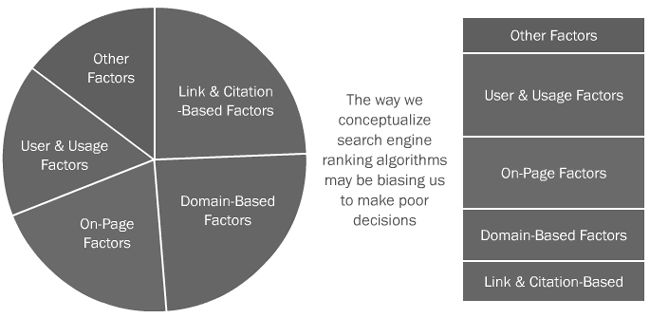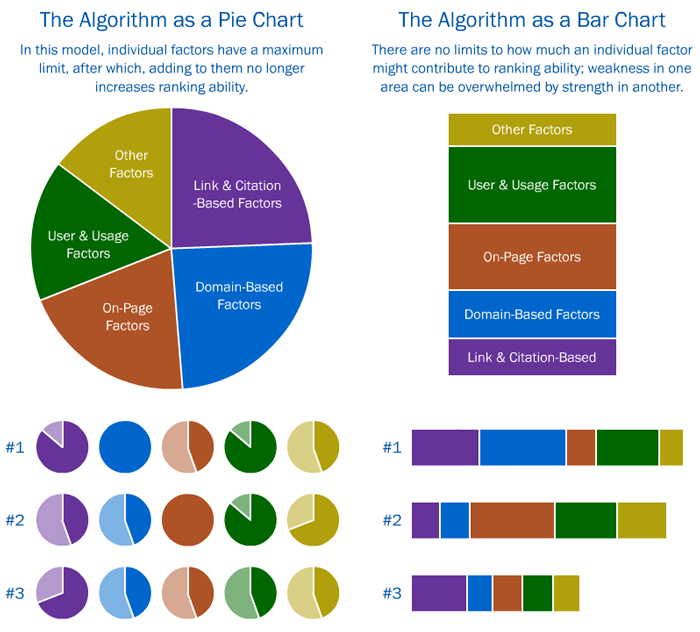Sometimes we make assumptions that lead us in the wrong direction. I’ve made plenty, and I’ll continue to make them for as long as I’m alive. And sometimes, we’re inadvertently responsible for wrong assumptions made by others. When that’s the case (and we notice it), there’s an obligation to correct the misunderstanding.
I recently encountered an example of this in some advice related to the SEO field, and how to optimize for rankings. That advice referenced SEOmoz’s own Google Ranking Factors article, which uses a pie-shaped diagram to illustrate “percents” of particular algorithmic factors (like the illustration on the left in the image below).

This visualization, and the conceptual takeaway that the ranking algorithm is a pie chart made up of buckets that can only be filled so much, got me worried that a series of assumptions might lead a lot of folks astray.
Here’s the problem – if we imagine the algorithm as a pie chart, each factor (or each type of factor) is only able to contribute a limited amount to the potential final ranking position for a given term/phrase. But, that’s probably not the case. It’s more likely that ranking elements don’t stop positively contributing to the ranking process once they reach “100%,” in fact, there’s probably no such thing as “100% optimized for domain authority” or “100% optimized for link/citation/social factors.” As more positive signals are earned toward these elements, the overall ranking ability of a page simply rises.
I’ve tried to illustrate this below in a very simplistic fashion:

(do not take these charts to mean anything about my opinions of ranking elements, they’re just crude diagrams)
Some notes:
- In pie-chart world, once a factor has been “optimized” to its maximum degree, there’s no point in spending additional energy on it.
- In bar-chart world, the contribution of a factor never ends. It could be that some factors don’t influence as much as others, but each will exert additional ranking force of some level as it gains strength.
- Pie-chart and bar-chart thinking are mutually exclusive – you can’t have both (at least, as they apply to a single factor)
My personal guess is that neither pie nor bar chart are the entirely right way to think about SEO. There might be some elements that have a maximum level of contribution they can make to a ranking position, and others that will add ranking ability ad infinitum.
The assumption I’m worried about comes from using the pie-shaped conceptualization, and biasing ones work or tactics based on the idea of percentile-optimization.
I think the industry overall may have made a mistake when we assumed the acronym “SEO” or “Search Engine Optimization.” The word “optimization” inherently suggests that the practice is somehow analagous to crafting a lock to fit a keyhole. The perfect combination of ridges, grooves, and smooth sections will open the lock, and continuing to perfect a key after it opens that lock is pointless.
SEO isn’t that way. And tragically, I’ve probably confused a lot of people by using a pie-shaped chart in our ranking factors, and by writing posts with titles like Perfecting Keyword Targeting & On-Page Optimization. Even though these contain caveats, there’s undoubtedly marketers walking away from these materials who’ve been given the wrong impression.
My apologies to anyone who’s been confused – from here on, I’ll work to make sure that I don’t present SEO in this misleading fashion, and that future articles we publish to replace these older ones will work harder on both visuals and linguistics around the topic. Unfortunately, I’m going to have a harder time getting rid of the idea that “SEO” presents in its naming convention. We’ve been fighting as an industry for so long against the concept that SEO is a one-time activity, and all that time, our very nomenclature may have been one of our worst enemies…
